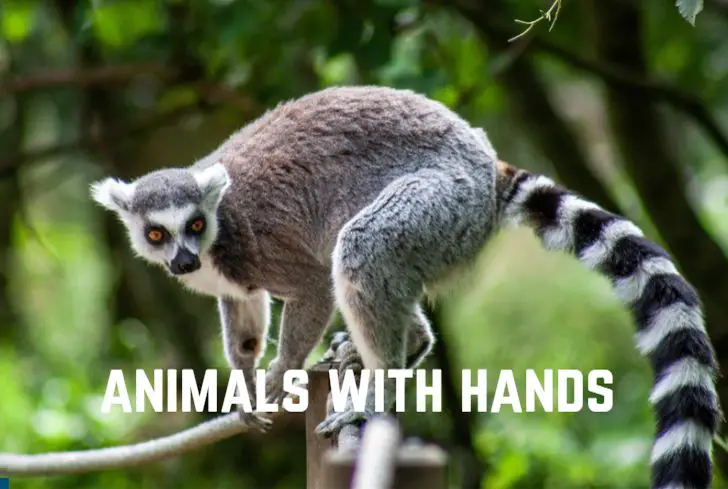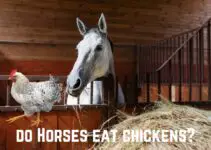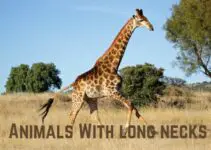With about 8.7 million animal species worldwide, it may be hard to differentiate their names and appearance. But if you have ever thought about animals with hands, you imagined animals with opposed thumbs. These animals have a pair of hands similar to and function like human beings.
If you are researching animals with hands, this post is for you. We have carefully composed 13+ animals with hands to help you easily identify these unique animal species.
Contents
List of 13+ Animals with Hands
Animals with hands will have their hands functioning almost similar to those of humans. They have opposed thumbs that can flex and rotate to touch other fingers. There are a few such animal species that can do this task.
Read: 15 Gorgeous Green Birds in Florida
Here is a list of 13+ animals with hands you need to know:
1. Lemurs

Lemurs are the first species of our animals with hands list. These are unique creatures originally found in Madagascar island, and you can find them on other minor islands on the African coast.
There are around 100 lemur species, some of which can be identified for their unique nature. All these have hands, but some scientists argue that they have pseudo-opposable thumbs, implying that they cannot rotate and flex to touch other fingers. Nonetheless, lemurs use their hands to eat food and grasp branches.
2. Giant Pandas

Giant pandas are well-known creatures for their laziness. Also, these gorgeous animals have hands with opposed thumbs, known as false thumbs. This is because their thumb is an extended carpal bone.
Giant pandas’ thumbs function similarly to opposed thumbs, and they can use them to clasp their dear bamboo shoots. These creatures have a carnivore digestive system, although they specifically feed on bamboo.
3. Koalas

Also known as Australia’s lazy animals, koalas are cute animals with great hands. These have only two opposable thumbs, implying they have two thumbs in one hand. These thumbs enable them to quickly and securely grasp branches.
Their second thumb replaces the little human finger. Koalas feed on low-calorie food, making them sleep more than other animals (18 hours).
4. Possums

Possums belong to the group of mammals known as marsupials and are mainly found in Australia. These animals feature hands that enable them to adopt their general lifestyle. Generally, their hands have opposable thumbs, while others have them on their feet.
Possums have an arboreal lifestyle and are fond of living above the ground. Amazingly, they quickly climb trees, grab branches, and have an easy time in the wilderness using their thumbs. Also, these creatures have a robust immune system against the venom of various types of snakes found in the environment.
5. Waxy Monkey Leaf Frogs

You could not have possibly imagined having frogs on our animals with hands list. Generally, these frogs are known as monkey frogs for a specific reason. They belong to a group of arboreal frogs, implying that they dwell on trees and they require something to grab branches which are hands.
These creatures have opposable thumbs on their hands which are much helpful. Also, unlike other frogs, these frogs walk instead of jumping or hopping.
Read: 13 Impressive Animals With Feathers
6. Opossums

Opossums, widely confused for possums, are marsupials mainly found in Central America, Mexico, and North America. Unlike possums, their opposable thumb lacks claws or nails, implying that they don’t use them as a defensive weapon. However, they use opposable thumbs to climb trees and run fast on thin tree branches.
Opossums act dead when facing danger. These tiny marsupials also use their tail for arboreal reasons, making their life on trees seem easy. Nevertheless, they don’t have control over this defensive mechanism and have no time limit for staying in this state.
7. Chameleons

Chameleons are well-known for their tiny hands, which enable them to grab branches and climb various terrains as they look for food. You may have seen a chameleon on a small branch or twig, possibly because of their tiny hands.
Typically, these reptiles have two sections of fingers: the lateral and medial bundles. Also, they can move their eyes separately at 180 degrees, implying that they can view a full circle on its axis.
8. Old World Monkeys

This group of monkeys is native to Africa and Asia and is available in twenty-three different species. Some of them are macaques, grivets, and baboons. These creatures are familiar in that some have hands with opposable thumbs.
Thus, not all Old-World monkey species have opposable thumbs. Also, a colobus monkey belongs to a class of these monkeys and doesn’t have any thumbs.
9. Apes

Apes belong to a group of Old-World tailless primates naturally found in Southeast Asia and Africa. They mainly consist of chimpanzees, gorillas, gibbons, orangutans, and bonobos. Generally, all apes have hands and opposable thumbs.
Nonetheless, apes are unique— they have an opposable thumb on their feet. Generally, apes use their hands to climb trees, feast, grab branches, hold, and use tools. Their hands are helpful in their daily lives.
Additionally, some apes use their hands to build shelters out of leaves.
Apes and humans have 97 per cent DNA similarity, explaining why they have hands similar to humans. You may have possibly seen an ape grooming another, and this was possible because of their hands. Importantly, apes can pick fruits using their hands.
10. New World Monkeys

As the name suggests, New World monkeys are naturally found in America. These monkeys include the wooly monkey, night monkey, Yukari, capuchin, owl monkey, tamarin, and squirrel monkey. All these have hands that they use to grab branches, climb trees, and eat.
Some scientists argue New World monkeys have pseudo-opposable thumbs rather than opposable thumbs. This implies that their thumb cannot do things that an opposable thumb does. Nonetheless, if you keenly observe a New World monkey, you will notice how they use their mighty quire hands excellently.
11. Red Pandas

The red pandas have an opposable sixth front toe. This physical adaptation enables them to quickly grab and eat bamboo leaves and shoots, which is their primary diet. These pandas are found in northern Myanmar, Nepal, and central China but mainly in Eastern Himalayas.
12. Brushtail Possum

Although most people confuse brushtail possum for Virginia Opossum, these possum species are mainly found in New Zealand and Australia. Typically, these creatures are grey-colored with white and cream underparts and a black band on their snout. They are primarily arboreal and feed on insects and leaves; some people consider them pests.
Brushtail possums have two thumbs on their forefeet which enables them to climb. Also, they have a hand-like back foot which allows them to grab branches with their four climbing limbs, in addition to strong, sharp claws and a prehensile tail that allows them to curl across the tree branches.
Read: 13 Stunning Animals With Pouches
The typical brushtail possums live a solidarity life and can communicate with each other using their scent and sound. Also, their voice is characterized by intense rattling nasal hisses and coughs.
13. Baboons

Baboons belong to old-world monkeys and have opposable thumbs. These monkeys have non-prehensile tails (tails that grab and hold objects). Generally, these creatures live in open woodland areas across northern Africa.
Other species of baboons are found in Saudi Arabia. These creatures are highly social and omnivorous and live in packs of up to 150.
14. White-Handed Gibbon

White-handed gibbons are small-sized apes with thick, soft fur. These creatures live in trees and prefer living on the trees’ canopies. This is possible by using their hands with opposable thumbs, which enable them to swing with less struggle on tree branches.
They can also change direction within a split second, catch birds in midair and consume them after landing. These creatures are considered the fastest among all primates. Also, they are quick enough not to touch a branch before swinging and grasping the next branch, and they can fly and leap up to 40 feet in the air before landing.
White-handed gibbons’ hands give them an acrobatic technique that makes them cross large rivers and openings in the forest. However, they sometimes fall accidentally and suffer from bone weaknesses in the wild.
These creatures sleep while sitting and bending, their faces and knees buried in the chest and knees. Typically, they are bipedal and use their limbs to walk across trees. Also, they use their arms to gain balance when running across branches and the ground.
Wrapping Up
Learning about animals with hands is a fascinating topic that enables us to understand the adaptation of these creatures. Thankfully, we have identified 15 various types of animals with hands and opposable thumbs— you can have fun identifying these animal species!







